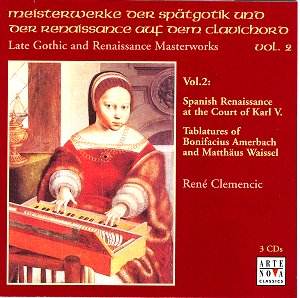
Luys Venegas de HENESTROSA Libra de Cifra nuevra, para teclas, harpa y vihuela (1557)
ANONYMOUS Himno II, Sacris solemniis
Francisco de SOTO (c. 1500-1563) Tiento XXIII
ANONYMOUS Fantasia sobre FA, MI, UT, RE
ANONYMOUS Fantasia XII
ANONYMOUS Fantasia XVII
ANONYMOUS Himno V, Pange lingua
Johannes URREDA (c. 1500) Himno VII, Pange lingua
ANONYMOUS Himno XX, O gloriosa Domina
Luys ALBERTO (1st half 16th century) Tres IV glosado de Luys Alberto
Gracia BAPTISTA (1st half 16th century) Himno XXII, Conditor alme
Jean MOUTON (c. 1459-1522) glosado de Palero: Motet III, Quaeramus
Jachet de MANTUA (c. 1550) Motete I Aspice Domine
ANONYMOUS Fabordones llanos 1,2,4,5,6
ANONYMOUS Fabordones glosados 4,5,6,9,7
ANONYMOUS Fabordones llanos 8,9,10, glosado 1
Antonio de CABEZON (1510-1566) Himno I, Pange lingua
ANONYMOUS Tres I
ANONYMOUS Fantasia XVIII
From the tablatures of the Basle Humanist Bonifacius Amerbach (1495-1562)
Heinrich YZAAK (c.1450-1517) In pace in id ipsum
Joannes KOTTER (c. 1485-1541) Harmonia in sol
Paul HOFHAIMER (1459-1537) Min einigs A
Heinrich YZAAK (c. 1450-1517) Si dormiero
Joannes KOTTER (c. 1485-1541) Fantasi in ut
Alexander AGRICOLA (1446-1506) Tota pulchra es
Joannes KOTTER (c. 1485-1541) Proemium in re
Joannes KOTTER (c. 1485-1541) Salve Regina
Joannes KOTTER (c. 1485-1541) Ad te clamamus
Joannes KOTTER (c. 1485-1541) Praeludium in la
Joannes KOTTER (c. 1485-1541) Anaboleh in fa
Joannes KOTTER (c. 1485-1541) Praeludium in fa
Joannes WECK (c. 1495-1536) Tancz der schwarcz knab
Paul HOFHAIMER (1459-1537) Zucht eer und lob
Maister Hans von CONSTANZ (1483-1538) Dantz Moss. Benczenauer
ATTEIGNANT (1529) Jay top ayme
ATTEIGNANT (1529) Amy souffre que je bous ame
ATTEIGNANT (1529) Je my plains fort
Joannes KOTTER (c. 1485-1541) En est iltx ung qui aym
Paul HOFHAIMER (1459-1537) Nach willen din
Joannes KOTTER (c. 1485-1541) Uss tieffer noot schry ich zu dir
Hans WECK (c. 1495-1536) Spanyoeler tancz
Joannes KOTTER (c.1485-1541) O herre got begnade mich
Joannes BUCHNER (1483-1538) Ach hulk mich leid.
Doulce Memoire Chansons, Madrigals, Songs, Motets and Preludes fomr the Tablature of Matthäaus Waissel (1540-1602)
Pierre PHALESA (1571) Preambulum I
Pierre PHALESA (1571) Preambulum II
Ludwig SENFL (1486-1543) Was wirt es doc
ANONYMOUS Zarth freundtlichs M.
Orlando di LASSO (1532-1594) Susanne ung jour
Claudin de SERMISY (c. 1490-1562) Cest a gran tort
Claudin de SERMISY (c. 1490-1562) Languire me fais
Claudin de SERMISY (c. 1490-1562) Le content est riche
Philippe VERDELOT (c. 1470-1552) Ave Jesu Christe
Clemens non PAPA (c. 1510-c. 1555) Je pres engre
Rogie PATHIE (c. 1510-1565) Si pourti quardo
Pierre SANDRIN (c. 1490-1561) Doulce Memoire
Orlando di LASSO (1532-1594) Veni in hortum meum
Benedikt de DRUSINA (c. 1520-1573) Quanto e Madonna mia
Rogier PATHIE (c. 1510-1565) D’amour me plains
Jacques ARCADELT (c. 1505-1568) Quand’io pens’al martire
Christian HOLLANDER (c. 1510-1569) Dum transisset Sabbathum I
Christian HOLLANDER (c. 1510-1569) Dum transisset Sabbathum II
ANONYMOUS Phantasia I
ANONYMOUS Phantasia II
ANONYMOUS Phantasia IV
Orazio VECCHI (1550-1605) Neapolitana
Orazio VECCHI (1550-1605) Neapolitana
Rec. January 2002, W*A*R Tonstudio, Vienna
BUY NOW